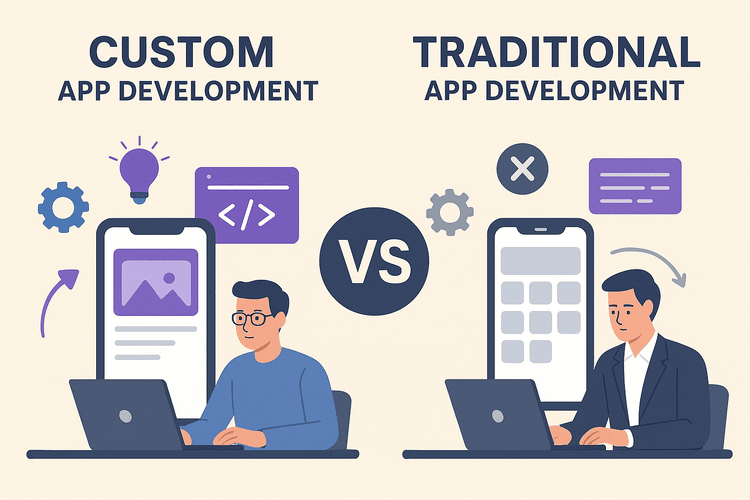Custom vs Traditional App Development — What’s Right for Your Business?
In today’s hyper-digital world, every business—whether a startup or a large enterprise—needs an app that not only represents its brand but also solves real customer problems efficiently. When it comes to building that app, companies often face one crucial decision: Should you go for a custom-built solution or opt for a traditional, off-the-shelf product?
Both approaches come with distinct benefits and challenges. Understanding these differences can help you make a more strategic decision aligned with your business goals, budget, and long-term vision.
Understanding the Basics
Before comparing the two approaches, let’s break down what each term really means.
Traditional (Off-the-Shelf) App Development
Traditional app development refers to ready-made applications that are designed for mass usage. These are pre-built solutions created to serve a broad range of businesses. You simply buy, subscribe, or license them and start using them right away. Examples include CRM systems like Salesforce, e-commerce platforms like Shopify, or project management tools like Asana.
These apps are usually cost-effective and faster to implement since they’re already developed and tested. However, they often come with limitations in terms of flexibility and scalability.
Custom (Tailor-Made) App Development
Custom app development focuses on creating software from the ground up, specifically tailored to a company’s individual requirements. Unlike off-the-shelf products, custom-built apps are unique to your business workflows, customer needs, and future goals.
Developers design and code every feature based on your preferences, ensuring the end product aligns perfectly with your brand and operations. While it typically involves higher upfront investment and longer development time, it provides greater flexibility, security, and scalability in the long run.
Key Differences Between Custom and Traditional App Development
To make an informed choice, it’s essential to evaluate both approaches across different business aspects:
1. Cost and Budget
- Traditional: Ready-made apps usually come with a one-time purchase fee or a subscription model. While they appear budget-friendly initially, hidden costs such as licensing fees, user limitations, and customization charges can add up.
- Custom: The upfront cost is higher because the app is built from scratch. However, there are no recurring license fees, and you maintain full ownership of the code. Over time, it can turn out to be more cost-efficient for businesses that plan for growth.
2. Time to Market
- Traditional: Off-the-shelf apps are plug-and-play. You can deploy them within days or weeks.
- Custom: Developing a personalized app takes time—usually several months, depending on complexity. But the end result is something that aligns exactly with your needs and can evolve as your business does.
3. Flexibility and Customization
- Traditional: Limited customization options. You might need to adjust your workflows to match the app’s capabilities instead of the other way around.
- Custom: Total control over design, features, integrations, and user experience. You can scale or modify the app anytime without being restricted by vendor limitations.
4. Integration with Existing Systems
- Traditional: Integration depends on whether the vendor supports APIs or third-party connectors. Often, compatibility becomes a challenge.
- Custom: Since it’s built around your existing infrastructure, integration with internal tools, CRMs, or ERPs becomes seamless.
5. Security and Compliance
- Traditional: Security depends on the vendor’s standards, which may or may not meet your industry’s compliance requirements.
- Custom: You can build robust, industry-specific security protocols directly into your app—ideal for industries like finance, healthcare, and e-commerce, where data protection is paramount.
6. Scalability
- Traditional: Limited by vendor updates or plan tiers. If your business grows beyond the app’s capabilities, migrating can be costly.
- Custom: Designed to scale with your business. You can easily add new features, expand capacity, or integrate emerging technologies like AI and IoT.
Advantages of Custom App Development
Choosing a tailor-made solution offers several long-term advantages:
- Personalized User Experience: You can create unique user journeys and deliver an exceptional user experience aligned with your brand identity and customer behaviour.
- Competitive Edge: A custom solution gives you features your competitors don’t have, helping you stand out.
- Long-Term ROI: Though initial costs are higher, you save money over time by eliminating recurring license fees and vendor lock-ins.
- Better Performance: Since the app is optimized for your specific use cases, performance tends to be smoother and more efficient.
- Full Ownership: You own the intellectual property and have complete control over updates and changes.
Advantages of Traditional App Development
Despite its limitations, traditional app development still makes sense for certain businesses—especially those with smaller budgets or simpler needs.
- Faster Deployment: Ideal for companies that need an app quickly.
- Lower Upfront Costs: No need for a big initial investment.
- Reliability: Established vendors often provide regular updates, maintenance, and customer support.
- Proven Solutions: Off-the-shelf products are already tested in the market, reducing the risk of bugs or performance issues.
When to Choose Custom Development
Opt for a custom approach if:
- Your business has unique processes that standard apps can’t handle.
- You need full control over security, scalability, and data ownership.
- You want to integrate multiple internal systems into one seamless platform.
- Your business is planning for long-term digital transformation.
Custom-built apps are particularly beneficial for industries like healthcare, fintech, logistics, and retail, where customer experience, compliance, and innovation play critical roles.
When to Choose Traditional Development
A traditional app might be the right fit if:
- You’re a startup or small business with limited resources.
- Your needs are generic—like CRM, email automation, or project tracking.
- You need something quick to test your business idea or market.
- You’re not ready to commit to large-scale infrastructure investments yet.
Many businesses even start with off-the-shelf apps and later transition to a custom-built solution once they scale.
Hybrid Approach: The Best of Both Worlds
Some companies are now adopting a hybrid model, combining the benefits of both approaches. For instance, you might start with a traditional platform and gradually customize specific modules as your business grows.
You could integrate APIs, add plug-ins, or even build new components around an existing base system. This strategy allows you to balance cost, time, and flexibility—perfect for businesses in transition.
Future Trends in App Development
The landscape of digital development is changing rapidly. Here are some trends shaping the future:
- AI-Powered Personalization: Machine learning is helping apps become smarter and more adaptive.
- Cross-Platform Frameworks: Technologies like Flutter and React Native make it easier to develop apps that work on multiple devices with a single codebase.
- Cloud-Native Development: Cloud integration is enhancing scalability and reducing infrastructure costs.
- Enhanced Cybersecurity: Data protection and privacy remain top priorities as apps handle sensitive user data.
Businesses investing in flexible, future-proof software—like custom app development—are better positioned to adapt to these evolving trends.
Conclusion: Making the Right Choice
Both custom and traditional app development have their strengths and weaknesses. The right choice depends on your business’s size, goals, and digital maturity.
If you need quick deployment and lower costs, traditional options can work well. But if your aim is to build a unique digital product that evolves with your brand, custom development offers far greater long-term value.
In the end, your decision shouldn’t be based solely on cost or speed—it should align with your business strategy, customer needs, and future scalability. Whether you choose a ready-made app or a custom-built solution, the key is to focus on creating an experience that delivers real results.








